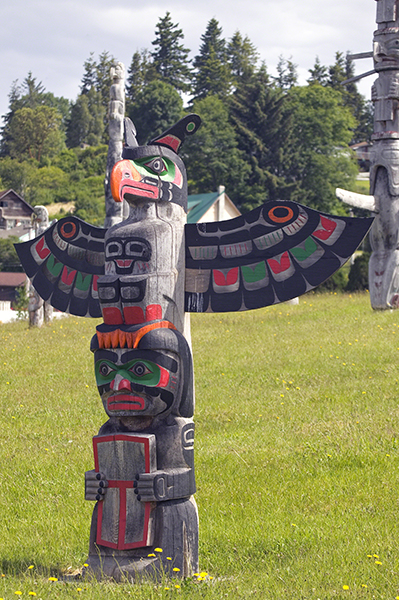Native American Heritage Month: The Totem Tradition
Of all the material culture produced by First Nations peoples of the Pacific Northwest, the totem is likely the most easily recognizable. Totems are monuments created to represent and commemorate ancestry, histories, people, or events. A totem pole would not necessarily tell a story so much as it would serve to document stories and histories familiar to community members or particular family or clan members. The raising of a new totem is usually celebrated with a feast or potlatch. Into the 21st century, totem poles continue to be an important part of First Nations ritual and cultural life in the Northwest.
 |
| Bruce Alfred (born 1950, Kwakwaka’wakw Culture, Alert Bay, British Columbia, Canada), Thunderbird and Copper Totem, 'Namgis Burial Grounds, Alert Bay, British Columbia, 1995. Cedar. Photo courtesy of Dr. Ron Wiedenhoeft, Saskia, Ltd. © 2023 Bruce Alfred. (PCD-0118) |
This totem by Bruce Alfred marks the building of a new road near the ‘Namgis Burial Grounds in Alert Bay, as well as memorializing those buried beneath the road. It was created after the resolution of a land claims issue with the Department of Highways and the province of British Columbia. Many of the bands of the Kwakwaka'wakw believe that their people once made a deal with a thunderbird for its help during a food crisis. In return, the Kwakwaka'wakw agreed to honor the thunderbird for all time. The outstretched wings on totem renditions of the bird are described as being twice as long as a First Nations canoe.
The copper held by the figure in the totem is called a tlakwa in the Kwakwaka'wakw language. The tlakwa is a copper plaque with a raised T-shape in the lower portion. It represents the wealth and status of its owner, meant to be displayed during potlatch ceremonies. When gifted or passed down, the copper increases in value. Each copper is unique and has a name, sometimes referring to an animal and sometimes referring to the copper's worth.
Among the Kwakwaka’wakw, potlatch are occasions for naming children, mourning the dead, transferring rights and privileges, marriages, and the raising of memorial totems. In contrast to European cultures, wealth was not determined by how much a clan had, but how much it had to give away at a potlatch.
Kwak'wala is the language of these related clans. Kwakwaka-wakw means "Kwak'wala speaking people." Oral history attributes the origin of Kwakwaka-wakw ancestors to the forms of animals, who discarded their animal forms to be humans when they arrived at a given spot. Animals from these origin traditions include the thunderbird, seagull, orca (whale), and grizzly bear. Ancestors who had human origins are thought to have come from other distant places.
Traditionally, the Kwakwaka’wakw were organized into thirty independent clans on northern Vancouver Island and adjacent mainland British Columbia around Alert Bay. There they relied on fishing, hunting, and gathering of wild berries and nuts for subsistence and trade. Their society was organized into three main classes based on heredity: nobles, commoners, and slaves. Slaves were often the gifts given away at potlatches. After first contact with Europeans in 1792, diseases they introduced drastically reduced the Kwakwaka’wakw population in the late 1800s and early 1900s. Today, the Kwakwaka’wakw maintain their culture and history through potlatches, preservation of the Kwak'wala language, and art.
Born in Alert Bay, Alfred apprenticed with Kwakwaka'wakw artists Richard Hunt (born 1951) and Doug Cranmer (1927–2006). He is most renowned for his traditional bentwood boxes, a technique he learned from Cranmer. Alfred has been instrumental in the growth and recognition of First Nations art in British Columbia. He was one of the contemporary Kwakwaka'wakw artists included in the landmark traveling exhibition Legacy—Tradition and Innovation in Northwest Coast Indian Art (1980) organized by the Royal British Columbia Museum. He was also involved in the development and growth of the U'Mista Cultural Center in Alert Bay.
Correlations to Davis Programs: Explorations in Art 2E Grade 1: 5.4; Explorations in Art 2E Grade 2: 5.6; Explorations in Art 2E Grade 5: 1.7., 1.8, 1.9; Experience Art: 2.1; A Community Connection 2E: 2.1; A Personal Journey 2E: 1.4, 2.3, 2.4; A Global Pursuit 2E: 2.5, 5.1; Discovering Art History 4E: 4.10


Comments